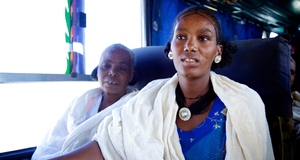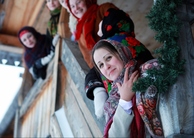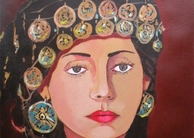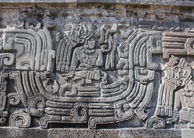The Modern and the Traditional: African Women and Colonial Morality
By
2017, Vol. 9 No. 10 | pg. 2/2 | « DanceIn “Cultural Anthropology and Human Challenge,” Haviland discusses the deliberate changes made by the British during colonialism to alter their subjects’ cultures in the name of improving their morality. The British, he explains, prohibited ritual dances because they were “erotic” and “immoral.” They introduced them to British “quiet and composed” games to replace the erotic dancing and open sexuality that normally followed the harvests. Traditionally, this was the time when chiefs sought to augment their prestige by hosting festivities with provocative dancing along with chanting full of sexual insinuation. To British colonialists, cricket seemed a good way to end all of this in a way would encourage “conformity to civilized comportment in dress, religion, and sportsmanship” (Haviland, 2005:408-409). This is another telling example of a notion of modernity that is completely opposite to the current notions where erotic dance and women’s revealed bodies are considered strong features not only of modernity but women liberation and empowerment. Toepfer, for instance, in “Nudity and Modernity in German Dance 1910-1930,” discusses the impulses within the German modern dance movement, in the first half of the twentieth century, which attempted to present the nude body as a sign of a modern and liberated identity. He explains that “the appearance of the nude dancing in Europe, was the discovery of modern relations between desire, the body, and the gaze” (emphasis is mine)(Toepfer, 1992). According to Toepfer, the use of nudity to signify the performance of modernity occurs at a time of quite unsystematic experimentation forging a modern attitude toward relations between desire and the body, yet, these relations are never remote from erotic significance. This illustrates the shaky and complicated first steps of Europe toward current notions of modernity which were, essentially, cultural features that colonial Europe fought at its colonies centuries earlier. This is especially true when we realize the reference in Toepfer’s discussion is to women. He states that “attitudes toward the modern nude, and especially female body (in dance) expose more complex and recessed attitudes toward modern, dance constructions or "performances “of sexual difference.” Toepfer emphasizes the importance of this type of dance, in which females are exposed, as a strong sign of modernity. Toepfer’s argument is to “use nudity in dance to equate “more modern” condition with the act of asserting a "more naked" identity.” That is to say the female’s nude body in dance equates a liberated empowered identity, that is, woman’s liberated identity.The fact that Europe was just “discovering” the “liberating” elements of the erotic dance which it prohibited in its colonies as indication of savagery and backwardness is illuminating. It begs the question again about the meaning of “modernity” and “tradition” or to be more specific the “modern and civilized” versus the “traditional and backward.” How are they defined, by whom, and according to what premises. Seemingly, it is appealing, given the discussion so far, to say that the modern, or at least the way it is popularly used, is equal to the Western or the European. While this answer contains some truth, it is a partial truth. For an examination of some episodes of the history of dance within the West reveals an interesting pattern. To narrow down what is “modern” and and what are its conditions more specifically, in the rest of this section I would like to highlight experiences of some of those emerged within the West as art, or more specifically, dance icons. In “African American Performance and Theater History” Elam and Krasner discuss the socio-cultural and political struggles that African American females dancers had to deal with in their careers. They highlight the stereotypes and racism that condemned the morality of African American females in general and dancers in particular. Elam and Krasner indicate that since “black women were mythologized as oversexed” and wedged between the needs to express their creativity and to obstruct the stereotypes, black female dancers were constantly under scrutiny for their “erotic” movement and pressed to choreograph according to the current codes of morality. That is why, they assert, Josephine Baker had to reject American morality and departs to Europe. Elam and Krasner narrate that when Baker arrived in Paris, unrestricted by Puritan morality, she fashioned the “Danse Sauvage” with the pattern of “exotic black.” In Europe, Baker faced “primitivism” -as Elam and Krasner call it- no less racist but a repressed one. Baker, however, was not the only black female dancer that struggled with the narratives of the oversexed immoral black woman. Aida Walker, for example, suffered contentiously from the “primitivism” in America and continued to modify her dance to suit the moral codes of the town she was visiting. Elam and Krasner point to the extreme difficulty under Jim Craw laws which imposed more racial restrictions on black female dancers urging Walker to restrain her sexual expression in dance (Elam and Krasner, 2001). Obliviously, Baker and Walker, among others, were stigmatized by the same notions of savagery and backwardness projected on African women by European colonialists. It only takes watching the film that chronicles Baker's life to know the descriptions heavily loaded with the moralized racism about the “half-naked negro” dancer. The names and slurs casted on Josephine Baker's dance resembles the descriptions casted by Long and Ripley and other colonialists about the “shameless” and “oversexed” African women which reflected the sexual anxiety of male colonialists and their repressions. However, to return back to the question about the meaning of modernity and tradition and the premises that generate them, it is evident that the answer that the modern is equivalent to the Western and European is not sufficient considering the cases of Baker and Walker. The narrative needs to exclude particular demographic within the West for it to be more specific. For if nudity and sexual dance was touted in a highly philosophical and aesthetic analysis offered in Toepfer’s article as strong features of modernity and women empowerment in German dance, why did it not apply to African American female dancers? Instead, African American female dancers had to deal with different type of constraining socio-moral code. Just to be accepted as regular citizens of a “modern” society, they needed to conform to the bourgeois morality. That is made clear in Fannie Williams’ statement written in the turn of the twentieth century that “showered with sexual and racial stereotypes, black women campaigned for respectability and moral authority….black women’s grave responsibility is to maintain bourgeois respectability because the negro is learning that the things our women are doing come first in the lessons of citizenship” (Elam and Krasner, 2001:197). It is understood that even the characters of the German female dancers Toepfer refers to in his article might had their share of stigma and condemnation given the bourgeois morality prevailing in the West at the time and the shaky steps it was taking toward “new features of modernity” and accepting them as liberating agents. Yet, they were not perceived as acting according to their inherent immorality and savagery based on their skin color like Baker and Walker were. In retrospective analysis about modernity and its features, African American female dancers, or people of African descent in general in the West despite their tremendous liberating contributions to social liberty, political rights, art and fashion in the West are never portrayed as liberating, “modernizing” or civilizing agents. Instead, they have always been associated with the “traditional,” “backward” and “immoral.” That is why I suggest excluding specific demographic within the West to be able to accurately describe what is “modern” as it is popularly used a fact that necessitates adding a racial dimension to its connotation. ConclusionIt is obvious from the cases discussed above that in every case of encounter between the West and Africa, and the Other in general, the modern and civilized has always been what the West is. Being civilized meant to behave and dress like a European. The fixation on women’s sexuality and considering it a measure of morality and propriety in Europe was projected on the rest to measure their level of civilization. Thus, since Africans and African women acted opposite to the Europeans in regard to sexuality and men-women relationship, they were considered lacking in civilization and described as traditional, and backward. Colonialists could not handle their sexual freedom and independence and posited them in the bottom of the ladder of civilization. Therefore, the intervention was to introduce patriarchal structure in which their sexuality was regulated and controlled the way it was in Europe. African women’s public presence was addressed through heavy campaigns on domesticity. Their revealed body signaled their savagery, therefore, required instructing them about decency and introducing all-covering outfits including the long dress and the headscarf. Their ritual dances with its erotic movements and explicit sexual chants needed to be eradicated and replaced with “composed appropriate civilized” games. However, when the West came to terms with the obsession with women’s sexuality and its implications on gender-imbalanced roles in the 1960s of the twentieth century more than a century later, it realized the means to women liberation and empowerment. Henceforward, sexual freedom, revealed bodies, and erotic dance became potent features of civilization and modernity in the West. Curiously, that shift did not happen without projecting its opposite, which used to be Europe’s past moral system, on the Other again. Hence, in illogical illusive way the Other continued to occupy the space of the uncivilized, traditional, and backward despite the fact that this Other was the original home of the new features of “modernity.” The fact that these new features of modernity have been ever present in the Other, that is Africa, is ignored and overlooked thereby allowing for ahistorical narrative of civilization and modernity backed by mendacious epistemology where modernity is portrayed as one-way process stemming from one and only source, that is the West. If the encounter of the West with Africans was about sameness and difference where the West recognizes itself against what it is not, then it would have been normal for Europe to define itself against its opposite. But this is not what we witness in the narratives of modernity and civilization. On the contrary, the West defines the rest, instead of itself, according to what the rest is not in correspondence with granting positive value to what the West is. In fact, “culture” seems to belong only to the rest while the West does not have “culture”; it has “modernity;” an exalted system aligned with science and philosophy; a higher construct beyond culture and above judgment. Evidently, the meaning of modernity shifted from one thing to its total opposite as we have seen in the themes of women's morality without ever changing who is civilized and modern and who is not. The West has always been the custodian of civilization and the source of modernity thereby assigning modernity to a particular geographic region: Western Europe and North America. Yet, realizing the fact that certain demographic categories within the West have been excluded and ignored like the rest of the world in modernity narratives, it seems that modernity is not only assigned to a particular geographic region but also to a particular race and to skin color. A glance at the contradictory meanings modernity and civilization held over time would make it appealing to think that the meanings of modernity is inconsistent. However, this inconsistency is only an appearance because these meanings are only manifestations for the same kernel. For modernity or “civilization” have been consistent on the following: Modernity is ethnocentric and coercive: during colonialism that was clear on rejecting the the difference of the subjects as lacking in morality and modernity and exerting tremendous efforts to assimilate them through imposing patriarchal structure, all-covering dress and headscarf, and “moral” dance. This coercion continues today, in the name of modernity as well, in the “headscarf” issue in France as one example. The contemporary criticism mounted on Muslims’ communities in the West, and some other cultural communities, for resisting assimilation is another example for modernity’s ethnocentricity and coercion. The pattern of coercion is also manifested in some developmental paradigms where individualism, for example, along with other Western cultural values, are prescribed as cures for the “Third World's” ills without which it would not make it to modernity. Modernity is assigned geographic home: In modernity narratives, the West has always been the modern in an illogical way that suspends modernity in a historical vacuum in which historical facts and events about the West and the rest, their interactions, and the shifts on their values and moralities are ignored. This dehistoricization resulted in a mythologized views about geographic regions where the West eternally assumed the position of the modern and other geographic regions have been and will always be traditional. Modernity is assigned to skin color: That was clear in categorizing colonial subjects according to the combination of skin color and “failure” to measure up to European moral yardstick. This combination has a continuation in the home of “modernity” in the case of African Americans and African diaspora where they are never identified with modernity despite their tremendous contribution to social liberty, political freedoms, and art generally but particularly in regard to women morality. This was evident in the case of Baker and Walker in contrast to the characters discussed in Toepfer’s article as liberating agents during the “discovering” of modernity and women empowerment through nudity and dance by Europe in early twentieth century. A candid look into the history of African diaspora would recognize its liberating impact on the West. It only takes intellectual integrity to realize the connection between contemporary features of modernity and the descriptions of Africans’ morality present in colonial reports. Modernity is defined according to what the West is and the Other is not: that is evident in the diametrically opposite meanings modernity connoted overtime without changing who is holding it. And here I would like to make a triangulation to explicate the complex contours in meaning(s) of modernity denoting the relation of the West with the rest. For instance, Mohammed Quttob’s criticism of nudity and sexual freedom in the West has been cited frequently to indicate how hopeless Muslims are to ever be modern. Yet, the condemnation of African women's sexual freedom by Europeans are not mentioned to indicate backwardness of Europeans. Neither were the slurs and prosecutions of African American female dancers by the state and the society perceived as “traditional” or/and backward. Additionally, the fact that the West did not take issue with women’s practices or dress habits in the Middle East during colonialism the same way it did with Africans seem to suggest that they (the West and the Middle East) had features in common. That is, the West condoned restrictions applied on women in the Middle East at the time. Yet, the West still labeled the Middle East, along with Africans, as traditional and backward in Orientalist paradigm. Thus, in a triangulation of the West, Africa, and the Middle East, the West has always occupied -and continues to occupy- the modernizing role toward the Other despite the cultural differences of these regions. Interestingly, in the current context, Africans are never described as “modern” in the current literature about modernity despite the presence of the cultural features regarding women freedom. The same practices described as signs of liberty in the West perceived differently in Africa. Africans are continued to be recognized as backward, this time however, based on different reasons that relate to economics, family structure and individualism, technology, etc. Muslims and the Islamic World, on other hand, are given the label of the traditional and backward primarily because of cultural traits concerning women freedom, dress and sexuality. The West always found a way to relegate the Other. Depending on what the socio-moral and technological features of the West are, modernity is defined and , correspondingly, the opposite of that definition is granted to others. In short, rather than having an objective neutral connotations of advancement and progress, modernity is fundamentally biased. It is not associated with progressive humanist values based on rationality as it is proposed to be. Rather, it is associated with exclusive geographio-racial moral system based on sentiment and passion. It is dehistoricized by delinking it from historical facts and contexts ignoring the shifts on values and moral systems and denying the “others” contributions. This makes modernity a fluid and nebulous concept that has been constantly adjusted to be equated with what the Western is while its opposite, the traditional, has always been equated with the Other in which Africans are the farthest from modernity regardless of historical facts. ReferencesBarker, Chris. 2005. Cultural Studies: Theory and Practice. London: Sage. Chanock, Martin. 1998. Law Custom and Social Order: The Colonial Expereince in Malawi and Zimbabwe. Portsmouth: Heinemann. Elam, Justin and Krasner, David. 2001. African American Performance and Theater History Reader. US. Oxford University Press. Fashion and Clothing Encyclopedia: Colonialism and Imperialism.http://angelasancartier.net/colonialism-and-imperialism Haviland , Prins, Walrath and McBride. 2005. Cultural Anthropology: The Human Challenge. Canada: Thomson Learning Inc. Hendrickson, Hildi. 1996. Clothing and Difference. North Carolina: Duke University Press. Najmabadi, Afsaneh.2006. Gender and Secularism of Modernity: How Can a Muslim Woman Be French? Feminist Studies, Vol. 32, No. 2 (Summer, 2006), pp. 239-255. Sexuality and Modernity: the Sexual Revolution of the 60s. http://www.isis.aust.com/stephan/writings/sexuality/revo.htm Stoler, Ann Laura. 1996. Race and the Education of Desire. North Carolina: Duke Univerity Press. Toepfer, Karl. 1992. Nudity and Modernity in German D ance,1 910-30. Journal of the History of Sexuality, Vol. 3, No. 1 (Jul., 1992), pp. 58-108. Young, J. C. Robert. 1995. Colonial Desire: Hybridity in Theories, Culture and Race. London Routledge. Suggested Reading from Inquiries Journal
Inquiries Journal provides undergraduate and graduate students around the world a platform for the wide dissemination of academic work over a range of core disciplines. Representing the work of students from hundreds of institutions around the globe, Inquiries Journal's large database of academic articles is completely free. Learn more | Blog | Submit Latest in Anthropology |


















